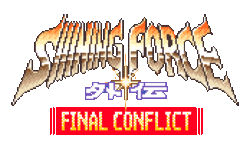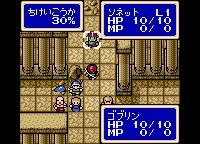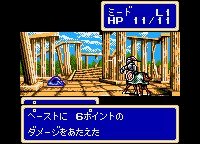|
|

|
PLATFORM
|
Game Gear
|
BATTLE SYSTEM
|

|
INTERACTION
|

|
ORIGINALITY
|

|
STORY
|

|
MUSIC & SOUND
|

|
VISUALS
|

|
CHALLENGE
|
Easy
|
COMPLETION TIME
|
Less than 20 Hours
|
|
OVERALL

|
+ Quick and fun combat
+ Easy to import
+ Good link between Shining Force 1 and 2
- Cramped screen
- Almost no exploration
|
Click here for scoring definitions
|
|
|
The Game Gear saw three Shining Force games during its lifespan. The first was never directly translated and the second saw localization as The Sword of Hajya, but both of them reached the Sega CD audience outside Japan in the form of Shining Force CD. Shining Force Gaiden: Final Conflict was not so lucky, as Sega's priorities in 1995 did not include the translation of Game Gear titles for the rest of the world. This final portable Shining Force from the team that would soon become Camelot is not necessarily worth the noticeable price it still commands, but for fans of the series' glory days it represents an opportunity to experience a lesser-known game which still possesses much of what made the Genesis games so enjoyable.
Final Conflict's narrative is not directly related to the earlier Game Gear titles, but instead serves to tie the two Genesis Shining Force stories together. Twenty years after the first Shining Force, that game's minor antagonist Mishaela is up to no good. Her goal is the eventual revival of Darksol, and stopping her proves beyond the ability of Max the hero and Adam the robot. Taking up the task of stopping the evil is a new group of characters who are led by Ian. Their journey will go through several areas familiar to players of the Genesis games before its conclusion.
Shining Force games prior to III were not known for their gripping plots, something that Final Conflict partially addresses. The sight of several personalities who played notable roles in the earlier Genesis games is fascinating, and this title's effort to connect the series is successful. On the other hand, Mishaela's trio of goons possess little personality yet get considerable screen time. This is another Shining title in which characters tend to join and then rarely say anything subsequently, though that was hardly unusual at the time.
 Sonnet is about to attack a goblin, but her onslaught includes no poetry whatsoever.
Sonnet is about to attack a goblin, but her onslaught includes no poetry whatsoever.
|
|
When it comes to playing Final Conflict, the experience is very similar to its predecessors in the series. Up to twelve player characters assemble on a field and take their turns in an order roughly determined by agility, facing off against a variety of adversaries on the field in a familiar but quite effective tactical template. Efficiency is the order of the day, with the attack option coming up automatically when a character is in range to do so, and the command to hold position being the default choice without something in the area to affect it. The player has the choice of when to promote characters, anywhere from level ten to level twenty, but otherwise has no say in their development. It's a system that works superbly for creating entertaining fights without much extraneous information to clutter the proceedings, and works just as well here as it did with the earlier games in the series. Final Conflict is also an easy import, since combat works exactly as it does in the rest of the series. Shining Force Central has a complete translation of the dialogue, which is helpfully without any Kanji due to the small screen.
Being on the Game Gear isn't always a good thing, though. The display of character status takes up enough room on the small screen that it can be hard to see what a protagonist is bumping against when at the top of his or her movement area, forcing the player to go back for a reconnoiter. To denote whether characters can equip something they face forward or backward in the menu, which is harder to see than it should be on the Game Gear thanks to the tiny sprites doing it. Otherwise the game does a fine job of keeping the action viewable.
Another sign of this being a Game Gear title was shared by Shining Force CD, that of curtailed exploration. There are no towns in Final Conflict or any way to waste time before getting into a new fight, just a camp menu to let inventory be traded and provide functions that churches administer in the numbered titles. Periodically a merchant will appear alongside the camp to let new weapons be purchased. There are two optional characters to be found later in the game by searching specific spots, but aside from occasional treasure chests there is nothing else to be discovered. This is a shame considering how much there was to do outside of battle in numbered Shining Force titles, but not an irredeemable flaw when the fighting remains entertaining.
In some ways, Final Conflict's AI gives the original Shining Force's a run for its money. Waiting for the player to reach a certain point before moving is one thing, but some of these enemies will actually walk away from an arrow to the face instead of immediately fighting back. The fights themselves remain interesting despite moronic enemy behavior, with interesting notions for the time such as fog that gradually disappears from the field and sandworms that remain hidden until characters come close. Final Conflict handles character death just like other Shining games of the time, by letting the player pay to revive the fallen, who come back to life without any adverse consequences. Like the other Game Gear titles, this one is significantly shorter than console Shining Force games, and can be completed in fifteen hours without straining.
 Now Mead flings something at a piece of Paste, and the start to a joke merely awaits its punchline.
Now Mead flings something at a piece of Paste, and the start to a joke merely awaits its punchline.
|
|
Quite a bit of Final Conflict's music is borrowed from Shining Force II, and it sounds okay through the Game Gear's sound processor. Not very many tunes were used, however, and the total track listing is scanty. The combat cinematics look pretty good for an 8-bit system but can't compare with their brethren on other consoles, and it's a shame this title didn't get a cosmetic upgrade akin to Shining Force CD. Compared to other handhelds in the mid-90s, it looks pretty good though.
Final Conflict can't claim the scale of its console counterparts, and its relative scarcity makes acquiring the game only for the dedicated series fans. Maybe it's the effect of playing so many lousy action games in the Shining series lately, but this one made me quite happy to experience one more sample of the glory days. Camelot has resisted all calls to make up with Sega over the years, while the owner of the Shining franchise has taken it in different directions over its recent iterations without returning to this simple yet vastly entertaining style. This is the way Shining Force was meant to be, and even with the constraints of the platform is fun to play today.
Review Archives
|









